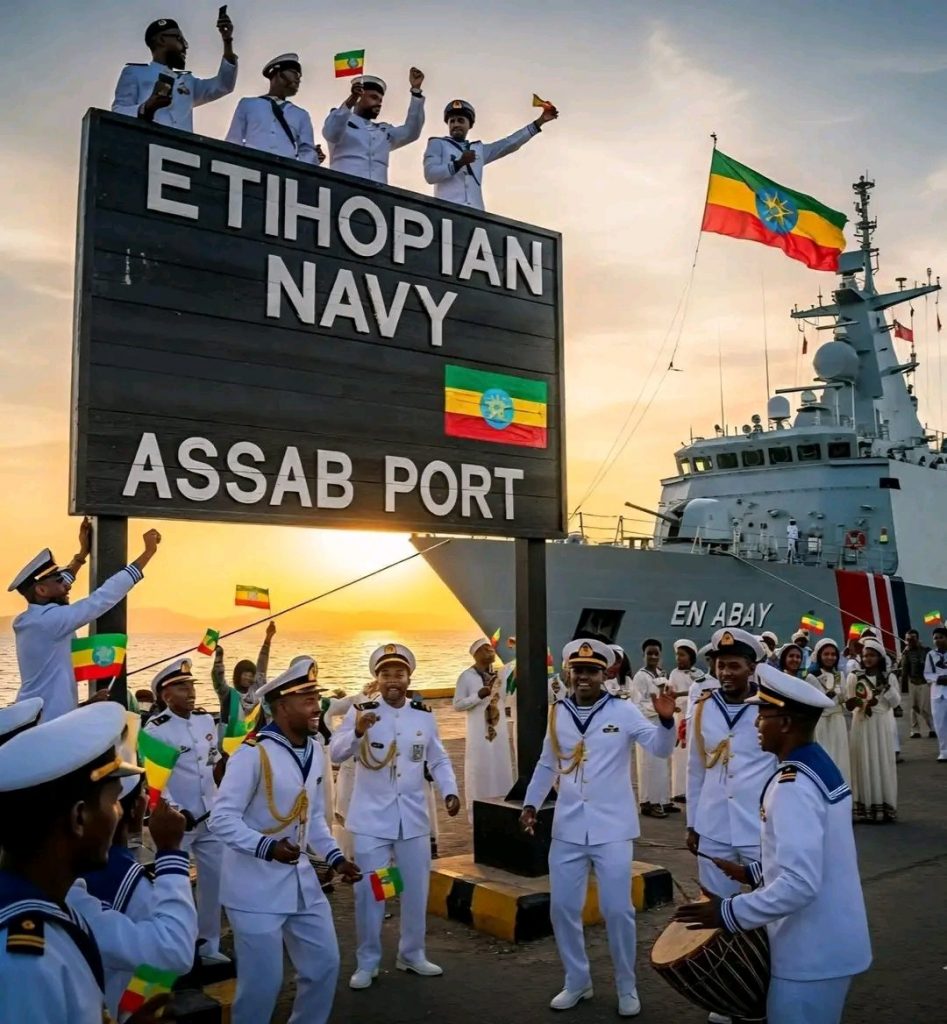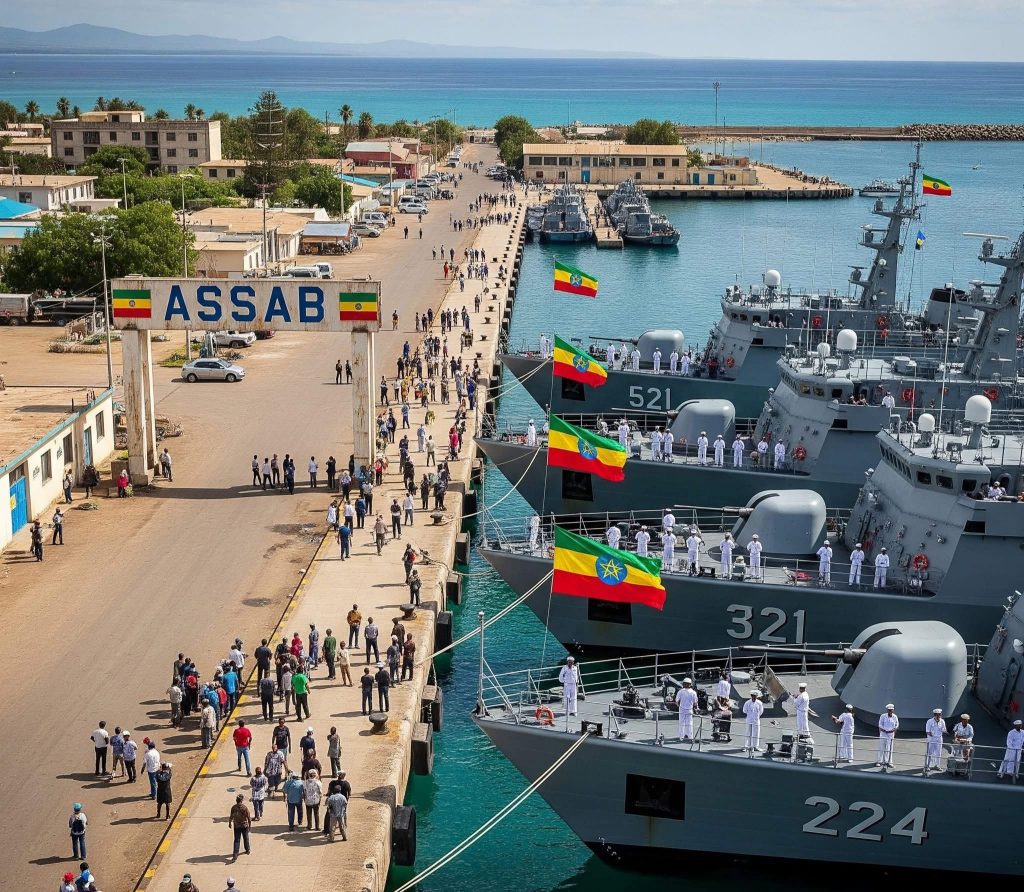On September 9 2025, Ethiopia inaugurated the Grand Ethiopian Renaissance Dam (GERD), a mega-dam with the capacity of generating 5000+ MW of energy. The ceremony was a highly mediatized event, with both state and social media ablaze as Ethiopians celebrated a dam that took 14 years and cost $5 billion to build. On the digital sphere, however, another peculiar phenomenon was happening alongside the celebrations: the proliferation of AI-generated videos and images. Some of these videos and images contained a not-so-subtle message about where Ethiopia should focus its efforts next: acquiring the Eritrean port of Assab.
One AI-generated video, widely circulated on TikTok and X, and shared by a former State Minister, celebrates the completion of the dam while calling for taking over the Assab port as the next goal. The video starts with a fictional mega-stage simulating a concert at the site of the GERD, adorned by Ethiopian flags and surrounded by a loud synthetic audience. An AI-generated voice announces the following words:
“ኢትዮጵያዊ መሆን እንዴት ያኮራል!
የህዳሴው ዘመን ላይ መሆን እንዴት ደስ ይላል!
የቀይ ባህር ታሪክ ሰሪ መሆን እንዴት ያለ ክብር ነው!
ኢትዮጵያ ለዘላለም ትኑር!
ከአባይ እስከ አሰብ አንድ ህዝብ አንድ ልብ!
This roughly translates to፡
How joyful it is to be Ethiopian!
How joyful it is to live in the era of the Renaissance!
How honourable it is to be a maker of Red Sea history!
May Ethiopia live forever!
From the Nile to Assab, one people! one heart!
The announcement is followed by fully AI-generated patriotic music and a video. Towards the second half of the video comes an unmistakable message in English: “GERD 2.0 Coming Soon!” followed by “See you all in Assab!”.
The inauguration of the Grand Ethiopian Renaissance Dam (GERD) has sparked widespread euphoria among Ethiopians, symbolizing a historic triumph of national pride, sovereignty, and collective resilience. After 14 years of self-financed construction through domestic bonds and… pic.twitter.com/AKvNanQH56
— Birhanu M Lenjiso (PhD) (@BMLenjiso) September 8, 2025
This proliferation of such synthetic propaganda is happening amid tensions in the Horn of Africa over Ethiopia’s desire to secure unfettered access to the sea. In 2023, Prime Minister Abiy Ahmed announced that access to the sea is a matter of survival, lamenting that 150 million people cannot live in a ‘geographic prison’. This statement alarmed neighbouring countries which saw the announcement as a threat to their sovereignty and territorial integrity. This has created anticipation that a new round of inter-state war might be on the horizon, particularly between Ethiopia and Eritrea.
While Ethiopia repeatedly states it will pursue its ambition peacefully and diplomatically, its posture has grown more belligerent, with military leaders declaring in their public appearances that the army is ready to answer the call if the government gives it a ‘duty or responsibility’ for the task.
The Ethiopian case raises the broader question of how AI is increasingly leveraged for political propaganda, especially in such volatile geopolitical contexts. The use of AI for political propaganda is emerging as a major concern in contemporary democratic societies. AI-generated propaganda, sometimes referred to as ‘synthetic propaganda’ or ‘slopaganda’ involves the use of new generative AI tools to create synthetic images, audio and video for circulation on social media.

This new genre has become especially popular in the U.S. and Europe. Parties such as Alternative for Germany (AfD) and leaders such as Donald Trump have used AI in order to mobilize their support base and delegitimize adversaries using often hyperbolic and whimsical images and videos.[1] In much of the world, this is not only taking place under a right-wing populist context but also influencing geopolitical conflicts.
Preliminary ARM research shows a similar situation in Ethiopia where AI is emerging as a key tool amid a broader turn to visual propaganda by the government and its supporters. The synthetic videos and images regarding Assab that are flooding the digital environment to amplify the Ethiopian government’s official discourse illustrate an evolving trend. A close reading of the pictures and videos reveals the visual tropes and audio-strategies that characterize these messages, as well as the underlying narratives behind them.
Visually, the images and videos are crisp and colourful, almost always adorned with the nationalist imagery of the green, yellow, and red of the Ethiopian flag. They depict ultra-modern ports buttressing an expansive blue sea, ostensibly representing Assab and the Red Sea. Large arch-like signs that depict the location as “ASSAB” feature frequently. Military naval ships, sometimes in exaggerated numbers, are present, marked unmistakably as Ethiopian by the flags they carry. Navy sailors aboard them, in crisp white uniforms are depicted. Some explicitly contain the phrase ‘no more landlocked’ plastered on the sides of large ships.

Another popular text is “from GERD to Assab”, signalling a desire to ride a wave of support for the GERD to rally society to pursue the port agenda next. The Ethiopian army and its mechanized divisions taking over Assab is also a popular imagery. In other instances, the Prime Minister is featured alongside the port, illustrating the importance of the leader in articulating this vision of reclaiming the country’s lost access to the sea.
The proliferation of short form video means the sound accompanying the videos has also emerged as an important instrument of political messaging. AI-generated patriotic songs accompany the visuals. One AI-generated song, for instance, croons:
ሙሽራዬ፣ አሰብ ሙሽራዬ፡፡ መዉጫና መግቢያ፣ የህልዉናዬ፣
አይክፋሽ ሃገሬ ሰአቱ ተቃርቧል፣ ወደብ አልባ መሆን በቅርቡ ያበቃል!…
This roughly translates to:
Assab, my bride, the gateway and passage of my being.
Do not despair, my country – the hour has come; your landlockedness will soon be over!
🚨Now, back to our regular programming: #ASSEB😎 pic.twitter.com/WtZOZ0BXov
— ኢትዮጵያውያን🇪🇹🇪🇷 (@ethiopiansone) March 27, 2025
These videos and images are also accompanied by text amplifying the message either in the form of a caption or embedded within the video/image itself. One caption from a popular pro-government Twitter account reads “The Red Sea is in our past, and it must be in our future. For dignity, for development, and for generations to come, Ethiopia’s rightful access to the sea must be restored”. Another, accompanying an AI generated image of a port with Ethiopian naval ships, declares “My next summer vacation destination! #Assab #Ethiopia”.
Behind these visual tropes and audio-messaging are deeply ingrained narratives that justify and legitimize Ethiopia’s aspirations to reclaim its lost sea access. AI-generated content functions by appealing to patriotism, aiming to mobilize the nationalist sentiment of Ethiopians. The country’s landlockedness, and the manner in which Ethiopia lost its seacoast, are perhaps one of the few political issues that unite an otherwise fragmented polity. These videos aim to tap into this sense of loss and regret in an attempt to generate public support for the government’s ambitions. These images and videos paint an alternative imaginary of the future with the help of AI – a future in which Ethiopia has escaped the ‘geographic prison’ of landlockedness and rides on a path to ‘prosperity’.

This phenomenon illustrates that AI is heightening and accelerating visual propaganda, as it has become significantly cheaper to produce and disseminate content. Crucially, it highlights state actors’ ability to quickly recognize and tap into the changing nature of platform cultures, where short-form video has increasingly supplanted text as the preferred form of content among audiences. Just as importantly, it signals that the classic division between truth and falsity does not apply as an explanatory framework any more as we enter the ‘Fuck It’ era of AI-Generated Slop.
____
A version of this blog was first published on Global Voices.